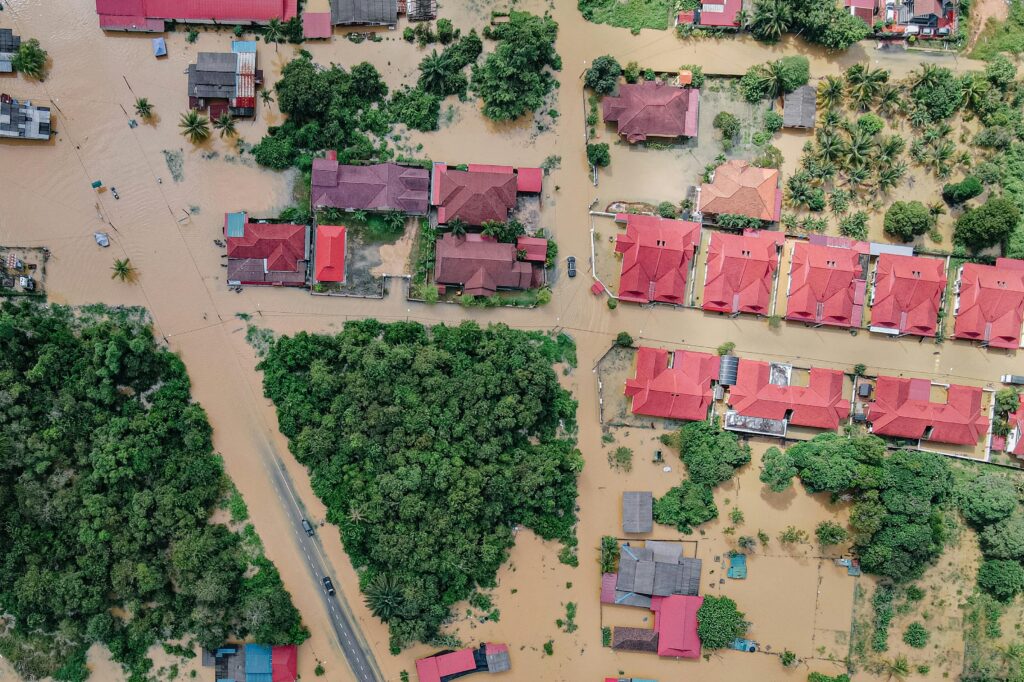
The Pakistan flood food inflation impact 2025 has become one of the most pressing economic issues in the country. Unprecedented floods have devastated farmland, washed away crops, and disrupted food supply chains. As a result, inflation is climbing, affecting both rural and urban households. This challenge is not only about rising prices but also about the overall stability of Pakistan’s economy.
Flood Impact on Punjab’s Areas
Punjab had some of the worst flooding in decades in 2025. Major agricultural districts including Rahim Yar Khan, Multan, Bahawalpur, and Muzaffargarh witnessed significant crop devastation, and thousands of villages were drowned. Farmers lost their main source of revenue when rice, corn, cotton and vegetable plantations were washed away. Transportation and trade within the province were disrupted by the damage to roads, bridges, and irrigation canals.
Entire communities were displaced, with many families losing homes, livestock, and farmlands. This widespread devastation has not only destroyed physical assets but also shaken the social and economic fabric of rural Punjab.
Financial Effects of the Floods in Punjab
The financial impact of the Punjab floods is severe and far-reaching:
Agricultural Losses (Pakistan flood food inflation impact 2025)
Punjab is Pakistan’s food basket, producing a large share of the nation’s staple crops. With fields destroyed, farmers face heavy losses, and national food supply has been disrupted. This has directly fueled food inflation across the country.
Rising Food Prices
Prices have increased due to the loss of vegetables, cotton, and rice. Essentials become more expensive as supplies run out, which puts further strain on household budgets and raises inflation overall.
Export Decline
Cotton and rice exports from Punjab generate significant foreign exchange. Their destruction has reduced export revenues, weakening Pakistan’s trade balance and increasing fiscal stress.
Damage to Infrastructure – Pakistan flood food inflation impact 2025
Roads, storage facilities, and irrigation systems require billions in reconstruction funding. This financial burden strains both the provincial and federal governments.
Debt and Credit Pressure
Farmers who rely on seasonal loans are struggling to repay debts, leading to rising defaults in the microfinance sector. Banks and credit institutions face increased risks, further weakening rural financial stability.
Increased Poverty and Job Losses
Daily wage laborers in Punjab’s farming communities have lost employment opportunities. As incomes fall, poverty levels rise, and more families require government or international aid.
Devastation from Pakistan Flood Food Inflation Impact 2025, flood goes much beyond just ruined land. They have caused a financial crisis in the agricultural sector, increased food prices, decreased exports, and put a great deal of strain on public resources. Punjab and the entire country would continue to experience economic aftershocks unless immediate alleviation and long-term resilience measures are implemented.

Pakistan Flood Food Inflation Impact 2025 – Financial Loss in Sialkot
Sialkot, known globally for its sports goods, surgical instruments, and leather industry, has faced heavy financial damage from the floods. The overflowing rivers and urban flooding damaged small manufacturing units and warehouses. Export consignments were delayed due to disrupted transport routes, and many factories halted production because of power outages and water damage.
- Export Impact: As Sialkot contributes a significant share to Pakistan’s export earnings, the damage has cut into foreign exchange inflows. Orders from international buyers have been delayed or canceled, weakening trust in supply chains.
- SME Losses: Small and medium-sized enterprises (SMEs), which dominate Sialkot’s economy, have reported millions in losses due to machinery damage and halted production.
- Employment: Thousands of workers who depend on daily wages in these industries have faced income loss, deepening local financial hardship.
Pakistan Flood Food Inflation Impact 2025 – Financial Loss in Lahore
Lahore, Pakistan’s second-largest city and its financial hub, has also experienced substantial economic setbacks from the floods. While Lahore is not primarily agricultural like Punjab’s southern districts, its urban economy has been severely hit.
- Business Disruptions: Commercial areas and markets were submerged, forcing retailers and wholesalers to shut down operations temporarily. This has slowed business activity and reduced sales tax revenue for the government.
- Property and Infrastructure Damage: Floodwaters damaged roads, bridges, drainage systems, and real estate, causing billions in repair costs. Homeowners and businesses are now facing unexpected financial burdens.
- Health and Education Costs: Hospitals, schools, and universities faced disruptions, leading to additional expenses for repair and restoration. This has added to the city’s financial pressure.
- Real Estate Slowdown: Investors are becoming cautious, and property transactions have slowed down, reducing cash flow in one of Lahore’s key economic sectors.
Combined Economic Effect
Both Sialkot and Lahore are vital to Pakistan’s economy—Sialkot for exports and Lahore for trade, finance, and services. The floods have disrupted their contribution to GDP and reduced overall tax collection. Together, these losses are expected to cost billions of rupees, widening Pakistan’s fiscal deficit and putting extra strain on already fragile economic conditions.
How Floods Are Driving Food Inflation in 2025
Thousands of acres of agricultural land in Punjab, Sindh, and Khyber Pakhtunkhwa were damaged by the floods in 2025. Rice, wheat, cotton, and vegetables are among the major crops grown in these provinces. Food supplies decrease and the cost of necessities increases dramatically when crops disappear. Furthermore, transportation routes have been damaged, making it difficult to move goods from farms to markets. This supply chain disruption adds another layer of pressure on prices, making the Pakistan flood food inflation impact 2025 even more severe.

Direct Impact on Households
The Pakistan flood food inflation impact 2025 is being felt most by ordinary families. With prices of basic goods like rice, wheat flour, and vegetables rising, households spend more of their income on food. This leaves less money for healthcare, education, and savings.
Families with low incomes are especially at risk because they already spend the majority of their budget on food. The cycle of poverty is exacerbated by rising costs, which compel people to cut back on meal quantities or substitute lower-quality options.
Government and Policy Response
To address the Pakistan flood food inflation impact 2025, the government has announced several measures. Emergency relief funds are being provided to farmers, while subsidies aim to stabilize food prices. The State Bank is also adjusting monetary policies to control inflation. However, these steps are short-term. For long-term resilience, Pakistan must invest in climate-resistant crops, modern irrigation systems, and flood management infrastructure. Without these changes, the cycle of floods and inflation will continue to harm the economy.
International Aid and Reconstruction
The international community has pledged support to help Pakistan recover from the floods. Financial aid, loans, and technical assistance are directed toward rebuilding infrastructure and supporting food security. These contributions are crucial for managing the Pakistan flood food inflation impact 2025 and preventing further economic decline.
Still, the challenge remains enormous. Reconstruction will take years, and Pakistan must balance urgent relief with sustainable development strategies.
Building a Resilient Future
The Pakistan flood food inflation impact 2025 highlights the urgent need for resilience. Investing in better flood defenses, diversifying crops, and improving food storage facilities can reduce future risks. Moreover, supporting small farmers with affordable credit and insurance will strengthen agricultural stability.
Conclusion
The Pakistan flood food inflation impact 2025 is more than a temporary crisis; it is a wake-up call for Pakistan’s economy. . Floods have caused significant hardship on households and the national economy, affected agriculture, and increased food prices. Long-term solutions are crucial, even while government action and foreign aid offer relief.
Pakistan can lessen the effects of future floods and shield its citizens from inflationary shocks by making investments in resilience, innovation, and sustainable policies.
